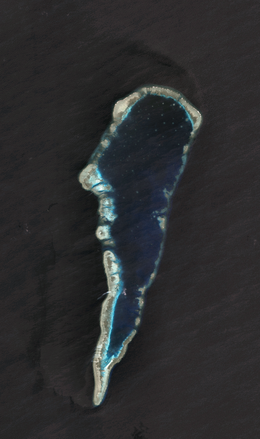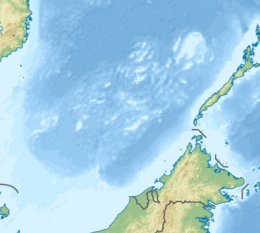Second Thomas Shoal
 Second Thomas Shoal | |
| Other names | Ayungin Shoal (Philippine English) Kulumpol ng Ayungin (Filipino) 仁愛礁 / 仁爱礁 Rén'ài Jiāo (Chinese) Bãi Cỏ Mây (Vietnamese) |
|---|---|
| Geography | |
| Location | West Philippine Sea |
| Coordinates | 9°44′N 115°52′E / 9.733°N 115.867°E |
| Archipelago | Spratly Islands |
| Administration | |
| Region | Southwestern Tagalog Region |
| Province | Palawan |
| Municipality | Kalayaan |
Second Thomas Shoal, also known as Ayungin Shoal (Template:Lang-fil; Template:Lang-vi; and Mandarin Chinese: 仁愛礁/仁爱礁; pinyin: Rén'ài Jiāo),[1] is a shoal or atoll in the Spratly Islands of the South China Sea, 105 nautical miles (194 km; 121 mi) west of Palawan, Philippines.[2] Claimed by several nations, the shoal is currently militarily occupied by the Philippines.
History
The shoal is one of three named after Thomas Gilbert, captain of the Charlotte:
- First Thomas Shoal – 09°19′N 115°56′E / 9.317°N 115.933°E (South of Second Thomas Shoal)[3]
- Second Thomas Shoal – 09°44′N 115°52′E / 9.733°N 115.867°E (Southeast of Mischief Reef)[3]
- Third Thomas Shoal – 10°54′N 115°56′E / 10.900°N 115.933°E (Northeast of Flat Island - some distance N of Second Thomas Shoal)[4]
Geographical location
Located south-east of Mischief Reef (09°55′N 115°32′E / 9.917°N 115.533°E), Second Thomas Shoal is near the centre of Dangerous Ground in the north-eastern part of the Spratly Islands; there are no settlements north or east of it.[3][4] It is a tear-drop shaped atoll, 11 nautical miles (20 km; 13 mi) long north–south[5] and fringed with coral reefs.[6] The coral rim surrounds a lagoon which has depths of up to 27 metres (89 ft) and is accessible to small boats from the East. Drying patches are found east and west of the reef rim.
Geographical features
On 12 July 2016, the tribunal of the Permanent Court of Arbitration concluded that Second Thomas Shoal is, or in its natural condition was, exposed at low tide and submerged at high tide and, accordingly, has low-tide elevations that do not generate an entitlement to a territorial sea, exclusive economic zone or continental shelf.[7]
Territorial claims
Second Thomas Shoal is claimed by the Philippines and China.[8]
The Philippine navy maintains a presence of less than a dozen navy personnel on the 100 m (330 ft) long Second World War US-built Philippine Navy landing craft BRP Sierre Madre (LT-57), which was deliberately run aground at the shoal in 1999 in response to the Chinese reclamation of Mischief Reef.[9][10] The Philippines claims that the shoal is part of its continental shelf,[11] while parts of the Spratly group of islands, where Second Thomas Shoal lies, are claimed by China, Brunei, the Philippines, Malaysia and Vietnam. In 2014, the Chinese government asked the Philippines to remove the grounded ship.[12][13]
Philippine supply ships subsequently avoided Chinese blockades in order to deliver food, water and other supplies to the garrison.[14] PRC coast guard vessels blocked two attempts by Philippine ships to resupply the garrison on March 9, 2014. Supplies were airdropped to the garrison three days later. A supply ship with replacement troops successfully reached the shoal on March 29, 2014 by sailing through shallow waters where the PRC vessels (with deeper drafts) were unable to follow. During the approach, Philippine crew members and troops on the resupply ship waved the peace sign at the pursuing Chinese coast guard crew.[15] Since then, the Philippine military has been sending monthly relief missions in the form of air dropped provisions to the troops stationed here.[16]
In November 2021, Chinese Coast Guard vessels used water cannons and blocked two Philippine supply boats, preventing the boats from delivering essential supplies to the Philippine marine forces stationed on the BRP Sierra Madre.[17]
Alternate names
The Singapore National University Gazetteer (Number 75967),[18] and the US NGA Gazetteer[19] list the following as other names for the Second Thomas Shoal:
- Mandarin Chinese - Ren'ai Jiao
- Other Chinese names - Jen-ai An-sha, Jen-ai Chiao, Jên-ai Chiao, Ren'ai Ansha, 仁愛暗沙, 仁爱礁, 断节
- Vietnamese - Bãi Cỏ Mây
- Filipino - Ayungin
- French - Banc Thomas Deuxième
- Other English names - Thomas Shoal Second
- Other names - Duanjie
References
- ^ Sailing Directions - South China Sea. Taunton: UK Hydrographic Office.
- ^ Sailing Directions Enroute : Publication 158 - Philippine Islands. Springfield, Virginia: US National Geospatial-Intelligence Agency (NGA). 2013.
- ^ a b c NGA Chart 93046 - SE Dangerous Ground
- ^ a b NGA Chart 93045 - NE Dangerous Ground
- ^ Sailing Directions (Enroute), Pub. 161: South China Sea and the Gulf of Thailand (PDF). Sailing Directions. United States National Geospatial-Intelligence Agency. 2017. p. 15.
- ^ "Imagery - Landsat 7 Path 118 Row 53". NASA. Retrieved March 21, 2014.
- ^ "Award" (PDF). Permanent Court of Arbitration. July 12, 2016. p.174
- ^ Robert C. Beckman; Ian Townsend-Gault; Clive Schofield; Tara Davenport; Leonardo Bernard (January 2013). Beyond Territorial Disputes in the South China Sea: Legal Frameworks. Edward Elgar Publishing. p. 19. ISBN 978-1-78195-594-9.
- ^ "A game of shark and minnow". The New York Times. October 27, 2013. Retrieved March 21, 2014.
- ^ Cohen, Michael. "Manila monitoring Chinese shoal moves". IHS Jane's Defence Weekly. Retrieved March 21, 2014.
- ^ "DFA statement on China's allegation that the PH agreed to pull out of Ayungin Shoal". Department of Foreign Affairs (Philippines). Official Gazette (Philippines). March 14, 2014. Retrieved April 9, 2014.
- ^ "China 'posturing' to seize Ayungin – Golez". Rappler. March 19, 2014. Retrieved March 21, 2014.
- ^ Esmaquel, Paterno (March 18, 2014). "China digs up details vs PH on Ayungin". Rappler. Retrieved March 21, 2014.
- ^ de Castro, Erik; Ng, Roli (March 31, 2014). "Philippine ship dodges China blockade to reach South China Sea outpost". www.reuters.com. Thomson Reuters. Retrieved April 1, 2014.
- ^ Gomez, Jim, Associated Press, "Philippine supply ship evades Chinese blockade", 29 March 2014
- ^ Campbell, Eric (May 20, 2014). "Reef Madness". ABC News. Retrieved May 23, 2014.
- ^ "Chinese vessels use water cannon to block Philippines vessels from disputed shoal". TheGuardian.com. November 18, 2021.
- ^ "Spratly Islands - Names" (PDF). Gazetteer 75967. National University, Singapore. Retrieved December 5, 2016.
- ^ "Spratly Islands Gazetteer". US NGA.

